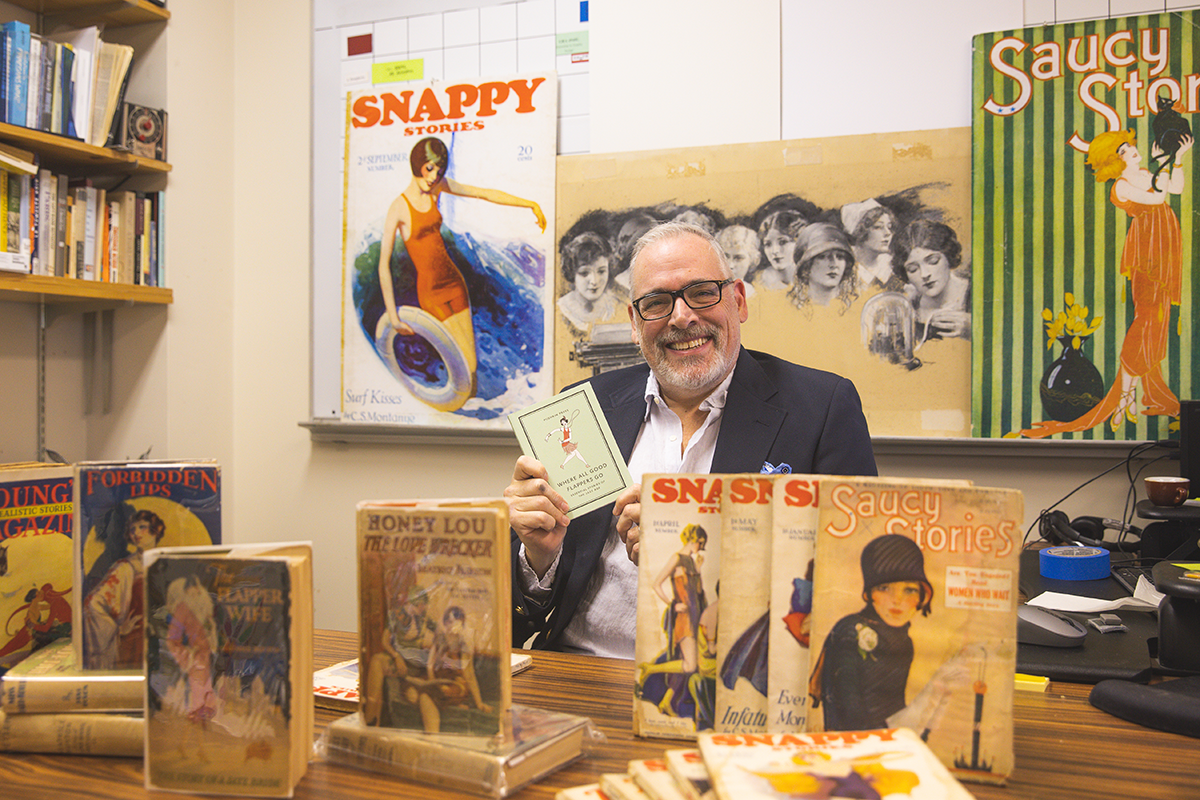UWF professor celebrates iconic 1920s flappers in anthology of short stories
In “Where All Good Flappers Go: Essential Stories of the Jazz Age," Dr. David Earle has assembled a collection of colorful short stories written primarily in the 1920s that celebrate the awe-inspiring charm of flappers: young women from the era who embraced an irreverent persona and unconventional attitude.

In “Where All Good Flappers Go: Essential Stories of the Jazz Age,” Dr. David Earle has assembled a collection of colorful short stories written primarily in the 1920s that celebrate the awe-inspiring charm of flappers: young women from the era who embraced an irreverent persona and unconventional attitude.
Earle is chair of the University of West Florida Department of Art and Design and professor in the English Department, where he specializes in Modernist literature and print culture. He conducted extensive research for the book, compiling many of the stories from pulp magazines — popular, inexpensive fictional publications that often included controversial content and captivating cover art.
While young American men were away at battle during World War I, young women flooded the workplace and cast aside the Victorian values and rules that had been expected of them. By the time the soldiers returned, the world had changed. Young women said “No, thank you” to high collars and “Yes, please” to flapper fashion, free-flowing liquor and life on their own terms. In the process, they became the model of modern femininity to young girls and important iconic figures in history.
“Flapper style, from the bobbed hairstyles to the short column dresses, was a reaction to the growth of modernization and the need for mobility among young urban women,” Earle said. “It was about riding bicycles, getting in and out of cars and dancing in speakeasies. You couldn’t do that in Victorian bustles and corsets.”
Earle said the flapper figure was about much more than just changes in fashion. It was also about changes in cultural equal rights and the rejection of double standards for men.
“Women wanted equality in their daily lives,” Earle said. “They wanted equal access to jobs and education. They wanted the right to smoke a cigarette, have a drink and explore sexuality like men did. The flapper became a symbol of liberation and a figure of rebellion.”
In the early 1900s, Americans relied on newspapers and magazines to learn about the world and topics of popular culture.
“In 1920, radio had just started and very few towns had bookstores,” Earle said. “But everyone had access to drug stores that sold mass pulp magazines which were full of short fiction literature on a variety of topics.”
According to Earle, the most popular and best-selling genre was romance magazines for women, but flapper magazines appealed to both men and women.
“There was a whole family of magazines dedicated to flappers and flapper culture,” Earle said. “They used the flapper as a figure of fascination for men and of envy for women. You saw high society stories about beautiful women trying to get handsome bachelors, but you also saw stories about working girls learning how to be modern in the city and navigate the dangers of the workplace. Flapper characters were chorus girls, gold diggers, real estate agents and reporters.”
African-American flappers were an important part of the cultural phenomenon, and three of the featured stories in the book were compiled from African-American newspapers.
“It was important to me that African American voices were represented in the book because mass culture borrowed so heavily from African American culture,” Earle said. “There would be no flappers without Jazz music, which became the soundtrack for flapperdom.”
While many of the writers in the book went from writing for magazines to becoming famous and successful authors, many were lost and forgotten. That’s what led Earle, a self-described literary archeologist, to rediscover the flapper stories and bring them back to life.
“Dawn Powell has become a favorite literary author who is now back in print,” Earle said. “F. Scott Fitzgerald went on to write ‘The Great Gatsby’ Viña Delmar wrote a bestselling book in 1928. Other writers, like Dana Ames, had been completely lost. Anita Loos wrote the most famous flapper novel, ‘Gentlemen Prefer Blondes’ but her story in the book ‘Why Girls Go South’ had only been republished once or twice.”
Earle said the illustrations and artwork in flapper magazines were as alluring as the stories.
“Flappers were consciously visual by the way they dressed; by the way they wore makeup; by the way they acted,” Earle said. “It helped them carve out their own space in the world. The illustrations were an important part of telling the stories. They helped readers paint a visual picture of who the flapper could be.”
One of Earle’s favorite authors in the book is Viña Delmar, who grew up in the Bronx in a theater family. She began writing stories for “Snappy Stories Magazine” and became the model for its flapper illustrations. In “Thou Shalt Not Killjoy,” Delmar tells the story of a flapper with a very conservative boyfriend who gets him to start reading and eventually writing for a flapper mag.
“Delmar writes very funny dialogue,” Earle said. “Her characters are flippant, powerful and funny. She is an author that literary history should really look at again.”
Earle said modern readers will enjoy the stories because they are really funny and at times address issues that are still debated today.
“Some of the stories speak to issues like abortion, sexuality or how to navigate a masculine-dominated workforce,” Earle said. “At the same time, the stories do illustrate how far women have come, which is very much a great lesson.”
Above all, Earle said “Where All Good Flappers Go: Essential Stories of the Jazz Age” is about bringing back to life colorful, fun stories written by very talented authors.
“These were wildly popular stories in very popular magazines,” Earle said. “Ultimately, these stories are meant to be enjoyed. This is really entertaining stuff.”
Published in the U.S. and Europe by Pushkin Press, a division of Penguin Random House, “Where All Good Flappers Go: Essential Stories of the Jazz Age” has sold out its first printing in Europe and is available on Amazon.
Earle will discuss flapper authors of the 1920s and “Where all Good Flappers Go” at Experience UWF Downtown Lecture Series on Nov. 16, 2023 from 5 to 8 p.m. at the Pensacola Museum of Art. The event is free and open to the public.



